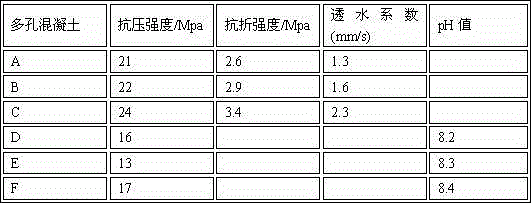Porous concrete prepared from waste road concrete aggregate and preparation process
A technology for waste concrete and porous concrete, applied in the field of concrete, can solve the problems of low strength of porous concrete, can not reach porous concrete, affect normal use, etc., and achieve the effect of changing the pH value, increasing the strength, and improving the pH value.
- Summary
- Abstract
- Description
- Claims
- Application Information
AI Technical Summary
Problems solved by technology
Method used
Image
Examples
Embodiment 1
[0033] Experiment time: October 20, 2013
[0034] Implementation location: laboratory
[0035] Room temperature: room temperature 20-25°C
[0036] Experimental equipment: vibrating screen with a gradation of 10-20, pulverizer, agitator
[0037] Experiment period: 30 days
[0038] The specific components and mass ratio of raw materials are: 1000kg of recycled aggregate, 500kg of steel slag, 250kg of cement, 4kg of polypropylene fiber, 150kg of sand, 150kg of water and 4kg of admixture. Agent, bentonite, natural rubber latex, fine iron powder, and organic flocculant are all 0.8 kg.
[0039] experiment procedure:
[0040] (1) Preparation of raw materials: 1) Preparation of recycled aggregate: use waste concrete after road reconstruction, expose it to the sun for 1-2 hours, then use a pulverizer to crush it into particles with a particle size of 45-60cm, and then expose it to the sun again After 1-2 hours, perform secondary crushing; after crushing into particles with a par...
Embodiment 2
[0050] Experiment time: January 20, 2014
[0051] Implementation location: workshop
[0052] Room temperature: room temperature 20-25°C
[0053] Experimental equipment: vibrating screen with a gradation of 5 to 15, pulverizer, agitator
[0054] Experiment period: 35 days
[0055] The specific components and mass ratio of raw materials are: recycled aggregate 1080kg, steel slag 540kg, cement 270kg, polypropylene film fiber 5kg, sand 180kg, water 180kg and admixture 5kg. , bentonite, natural rubber latex, fine iron powder, and organic flocculant are all 0.83 kg.
[0056] experiment procedure:
[0057] (1) Preparation of raw materials: 1) Preparation of recycled aggregate: use waste concrete after road reconstruction, expose it to the sun for 1-2 hours, then use a pulverizer to crush it into particles with a particle size of 45-60cm, and then expose it to the sun again After 1-2 hours, perform secondary crushing; after crushing into particles with a particle size of 30-40cm,...
Embodiment 3
[0067] Experiment time: February 20, 2014
[0068] Implementation location: laboratory
[0069] Room temperature: room temperature 20-25°C
[0070] Experimental equipment: vibrating screen with a gradation of 5 to 15, pulverizer, agitator
[0071] Experiment period: 40 days
[0072] The specific components and mass ratio of raw materials are: 1200kg of recycled aggregate, 600kg of steel slag, 300kg of cement, 6kg of polypropylene fiber, 200kg of sand, 200kg of water and 6kg of admixture. , bentonite, natural rubber latex, fine iron powder, and organic flocculant are all 1 kg.
[0073] experiment procedure:
[0074] (1) Preparation of raw materials: 1) Preparation of recycled aggregate: use waste concrete after road reconstruction, expose it to the sun for 1-2 hours, then use a pulverizer to crush it into particles with a particle size of 45-60cm, and then expose it to the sun again After 1-2 hours, perform secondary crushing; after crushing into particles with a particle ...
PUM
 Login to View More
Login to View More Abstract
Description
Claims
Application Information
 Login to View More
Login to View More - Generate Ideas
- Intellectual Property
- Life Sciences
- Materials
- Tech Scout
- Unparalleled Data Quality
- Higher Quality Content
- 60% Fewer Hallucinations
Browse by: Latest US Patents, China's latest patents, Technical Efficacy Thesaurus, Application Domain, Technology Topic, Popular Technical Reports.
© 2025 PatSnap. All rights reserved.Legal|Privacy policy|Modern Slavery Act Transparency Statement|Sitemap|About US| Contact US: help@patsnap.com

